The article Best 10 Attractions In Lausanne describes the 10 most scenic places in Lausanne. What do you know about the city of Lausanne?
Lausanne is a city on the northern shore of Lake Geneva in the Vaud region of French-speaking Switzerland. Among its most popular tourist attractions are the Olympic Museum and the Lakeside Olympic Park, and the city is also the headquarters of the International Olympic Committee.
And Lausanne is an old university town that has now become a bustling commercial city. It is a popular city for hosting conventions, trade fairs and conventions with a number of outstanding meeting places.
Nestled in a beautiful natural setting, the city is spanned by high bridges spanning the gorges of two rivers cut across the lake, with spectacular views of the Savoy Alps. Therefore, tourists visiting the city get a great opportunity to hike from the lake shore.

Antiquity of Lausanne…
Lausanne’s old town has medieval, shop-lined streets and an ornate 12th-century Gothic cathedral. The Museum of Fine Arts and Sciences is housed in the 19th-century Palais de Rumin.
BC In the first century, the Romans established a trading colony in this city. Lausanne Cathedral remains important today as a pilgrimage stop on the Way of St. James during the Middle Ages. Wander the winding streets beneath the cathedral to get a sense of the city’s history, and stroll down the lakeside promenade to capture the beauty of its late 18th-century grandeur as a highlight of the Swiss Riviera. The sleek lines of contemporary buildings such as the new Stage 10 Arts and Culture Center and the Flon neighborhood contrast sharply with ornate 18th-century and Belle Epoch buildings.

Transport to tour around Lausanne
The most convenient way to get around Lausanne is to use the smart, modern metro. Most useful for visitors is the steep M2 route, which runs from the Ouchy waterfront north to the Gare CFF station and the city centre, terminating at the Croisettes in the suburbs. This public transportation is completely free & during your stay, you will have free access to all public transportation in and around Lausanne.
Tasty Swiss Foods to Try in Lausanne
Lausanne, located on the picturesque Lake Geneva, is not only a beautiful and vibrant Swiss city, but it’s also a fantastic foodie destination. Lausanne as a delectable destination known for its chocolate, wine, and cheese. Here’s what you should eat when you visit Lausanne…
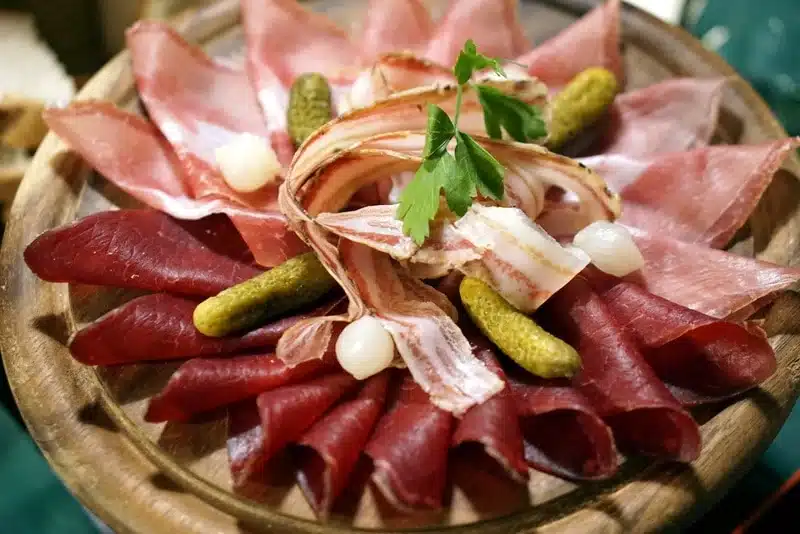
- Swiss Cheese.
- Delicious Cured Meats.
- Swiss fondue.
- Swiss Meringues.
- Fresh Berries.
- Chocolates.
- Wine.
Best Attractions In Lausanne City
Here’s a list of must-see 10 attractions in Lausanne that will make you forget about everything else during your visit to the lakeside town.
01) Lausanne Cathedral

This Cathedral is without a doubt a must-see attraction in the Vaud capital. An essential stop for any visitor. The Cathedral, regarded as one of Europe’s most beautiful gothic art monuments, commands a commanding view of the entire town, Lake Geneva, and the Alps.
A magnificent rose window with 105 frames of beautiful 13th-century stained glass can be found in the south transept. Look under the window to see the original stone sculptures from the Apostles Doorway, which have been preserved here. The cathedral’s interior is beautifully proportioned, with a 6,000-pipe organ as its focal point. The south aisle has carved choir stalls from 1509, and there are some early Gothic stalls in the choir.
The remains of an eighth-century basilica with tombs can be found in the crypt. With its five towers rising above the city from the hilltop, the early Gothic cathedral, which is now Protestant, is a landmark. A night watchman calls out the hours from 10 p.m. to 2 a.m. from the 72-meter-high central tower, as he has for more than six centuries.
02) Ouchy and lakeside
Head to Ouchy for a walk, a park siesta, or simply to admire the view of Lake Geneva and the mountains. It only takes a sliver of sunshine for the lakeside walkways to fill up with joggers, cyclists, rollerblades, and strollers. You simply must pause and treat yourself to an ice cream cone before relaxing in the sun.
The lakefront district of Lausanne serves as the city’s playground and the area has a breathtaking view. It’s where people come to spend a Sunday afternoon strolling along Lake Geneva’s shore with families, friends and swimming in the lake or at the Bellerive Plage open-air pool, or renting a SUP (stand-up paddleboard). There’s an extravagant air about the place, dotted with posh hotels dating from the nineteenth century, and you can enjoy some quality people-watching in one of Ouchy’s numerous bars and cafés.
Lausanne’s ferry port at Ouchy takes advantage of its location on one of Europe’s largest lakes, offering cruises to destinations around the lake. Take a short ride to the French spa town of Évian-les-Bains (directly opposite Lausanne), or float further afield to Geneva or the medieval French village of Yvoire.
03) The Sauvabelin Tower
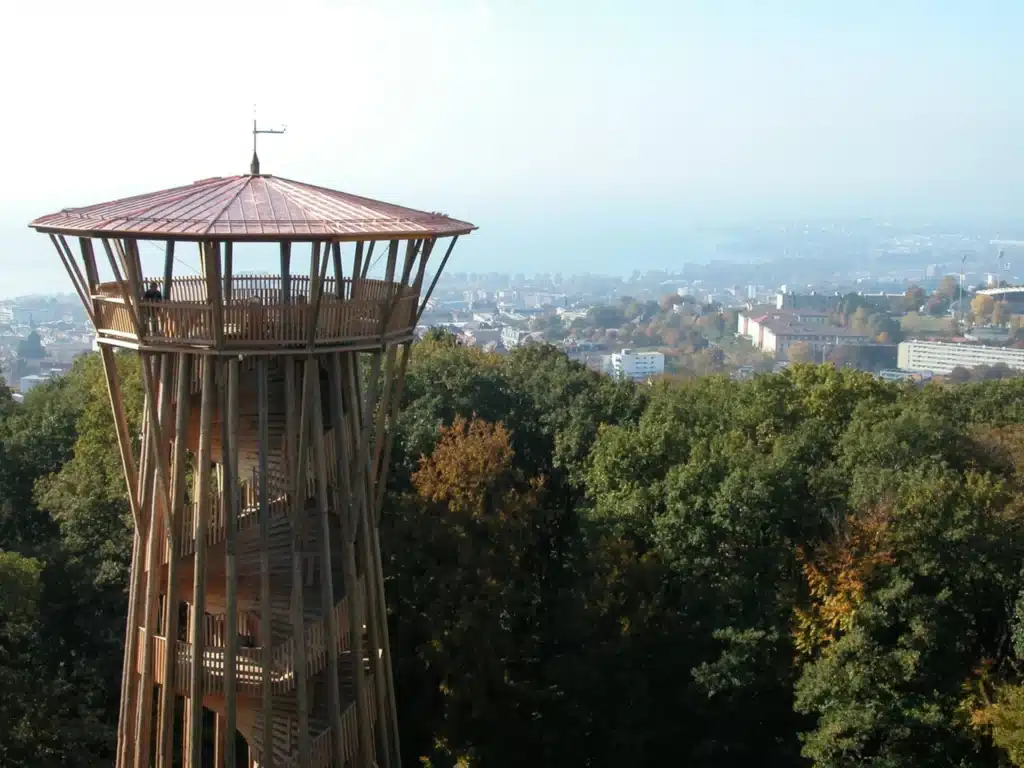
The 35-meter Sauvabelin Tower, built to commemorate the millennium, stands in the middle of a forest on a hill above Lausanne. This unusual round structure is made of locally harvested wood, primarily Douglas fir, and is filled with a wide spiral staircase of 302 steps that leads to an observation deck high above the treetops.

The 360-degree view from this vantage point includes Lausanne, Lake Geneva, the Swiss Alps, and the Jura region. The tower is located in a park with a small lake where boat rides are available, as well as a playground and a small animal park for children. The park and tower are both free, and the tower is open until 9 p.m. from March to October. It’s a popular spot for watching the sunset.
04) 10th Platform – Art Museums

Platform 10 is the city’s new arts district, home to the Cantonal Museum of Fine Arts (MCBA), the Museum of Design and Contemporary Applied Arts (mudac), and the well-known Photo Elysée.
The Musee des Beaux Arts (Museum of Fine Arts), which was previously housed in the 1906 Palais de Rumine, has already opened in its new location and houses a collection of art that, while small in number, is impressive in the quality of French artists represented. Works by Paul Cézanne, Edgar Degas, Auguste Renoir, Pierre Bonnard, Albert Marquet, Henri Matisse, and Maurice Utrillo can be found here, as well as a fine collection of graphic works by Swiss artists.
The Musée de l’Élysée, which is entirely dedicated to photography, combines significant and insignificant photographic moments. The images reflect local and global subjects, original and contemporary, and are dedicated to showing the many ways photography has represented people, places, and events. They were created by great names in art as well as complete unknowns. The museum tells the story of the medium itself, with early processes such as ambrotype, albumen paper, and photochrome on display.
The Museum of Contemporary Design and Applied Arts began as a decorative arts collection, but has since evolved into a forum for applied and fine arts to interact, particularly in the context of modern design. An annual exhibition program of five or more exhibitions focuses on young and emerging designers & their work.
05) The Geneva Lake

The jewel that makes Lausanne sparkle and its heart beat is Lake Geneva. The largest freshwater lake in Europe can be seen from a variety of viewpoints in Lausanne, including an esplanade, an unexpected opening between buildings, and a terrace. Lake Geneva is a crescent-shaped lake located between France and Switzerland. Its north shore offers beautiful views of the French Alps with the lake from Lausanne in the foreground. The Swiss Riviera stretches from Lausanne east to Montreux.
Relaxing on one of the small beaches along the waterfront, a short cruise on one of the Compagnie Générale de Navigation’s famous steamboats, wakeboarding, stand-up paddle boarding, and water-skiing for the more athletic, an outing on a paddle boat in Ouchy or a dip in the lake for those who prefer more sedate activities… The lake is an integral part of the Lausanne way of life.
06) The Olympic Museum
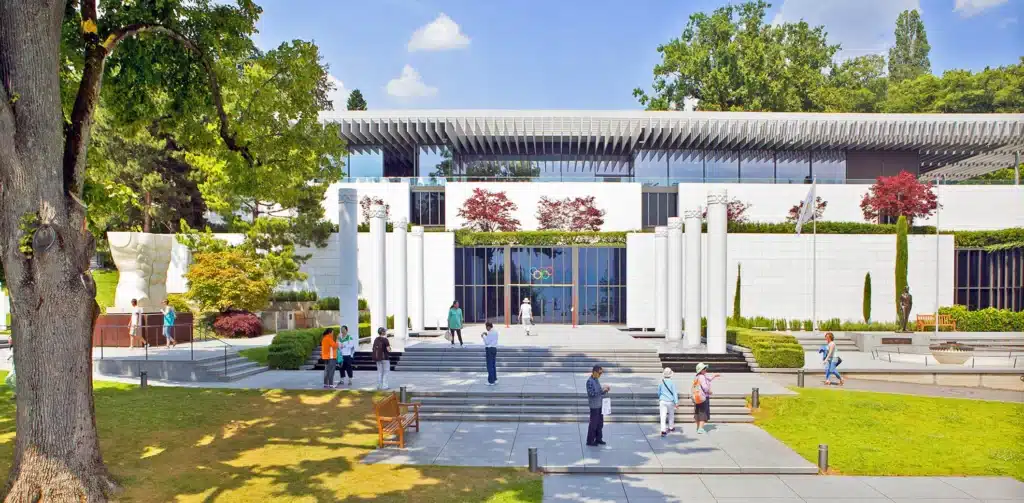
Lausanne is also a cultural city with internationally renowned museums such as the Fondation de l’Hermitage (fine art) and the Art Brut Museum. Among those on the list, the Olympic Museum is an absolute must for sports fans. An interactive museum that takes you through the history of the Olympic Games and will appeal to both children and adults!
This impressively Olympic museum was renovated for £36 million in 2013 and, it’s well worth a visit. The permanent exhibition, divided into three themes, relies heavily on interactive, multimedia displays, including games that put your physical and psychological skills in Olympic disciplines to the test. The lake is also visible from the café-restaurant.
The museum displays artefacts and history of the Olympic Games, focusing on the values of the Olympics and the qualities that made them so successful. The newly renovated exhibits cover the entire history of the Games, from their beginnings in ancient Greece to the most recent editions, and include Olympic torches, historic posters, equipment and Olympic costumes.
07) The Rochers-de-Naye Railway

The Glion-Rochers-de-Naye Railway, an electrically operated rack railway, connects Montreux to the mountain top of the Rochers de Naye. The line runs through Glion, a village on the hillside above Montreux, where it connects with the Territet-Glion funicular, which starts near Chateau Chillon.
Along with breathtaking views and skiing in the winter, there are precipitous Alpine gardens filled with rare flowers at the summit, as well as a Marmot house where you can observe and gain information about these Alpine mammals.
The opulent Hotel Victoria in Glion is located above the station and has a restaurant on its vine-draped terrace high above the lake. The Golden-Pass, a network of rail lines connecting Bern and Lake Geneva that restores the 19th-century elegance of rail travel, connects to the Rochers-de-Naye Railway.
08) Collection de l’Art Brut

The Collection de l’Art brut is a museum in Lausanne dedicated to outsider art. In 1945, the French painter Jean Dubuffet coined the term “Art Brut” and assembled the first collection of works bearing that moniker. Dubuffet considered preserving his collection in 1970. He chose Lausanne as a nod to his 1945 trip to Switzerland, which served as the foundation for his early discoveries.
The idyllic setting of the Château de Beaulieu became the setting for the first Art Brut collection, which included approximately 5,000 works, beginning in 1976. It now has over 70,000 pieces, including works by major Art Brut figures such as Alose, Adolf Wölfli, Henry Darger, Augustin Lesage, and Josef Hofer.
09) Cantonal Botanical Museum and Garden
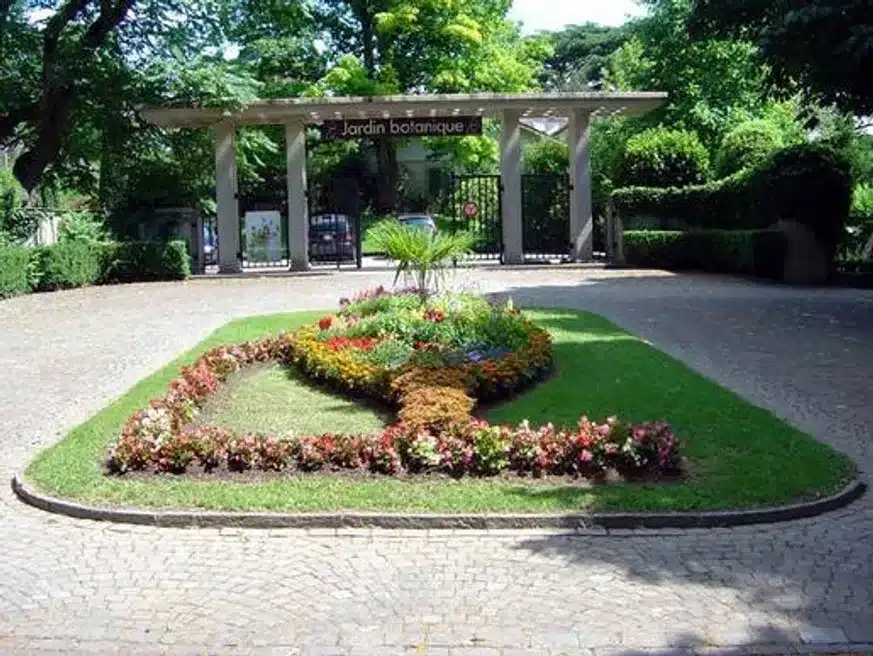
The Lausanne Botanical Garden invites you to discover nearly 4,000 alpine, medicinal, carnivorous, tropical plants… The visitor, during his walk, crosses an arboretum, a pharmaceutical garden, admires a collection of rockery plants from around the world and encounters various species of protected plants.
A hot greenhouse brings together tropical plants, utilitarian plants, spices, as well as a collection of orchids, while the succulent plant greenhouse brings together edible species. The Botanical Museum, open only during exhibitions or by appointment, houses a specialized library and preserves the Vaudois botanical collections, representing a total of more than 1,000,000 samples. You can consult various herbaria: Vaudois, Swiss, historical, as well as painted herbaria.
10) Market of Lausanne
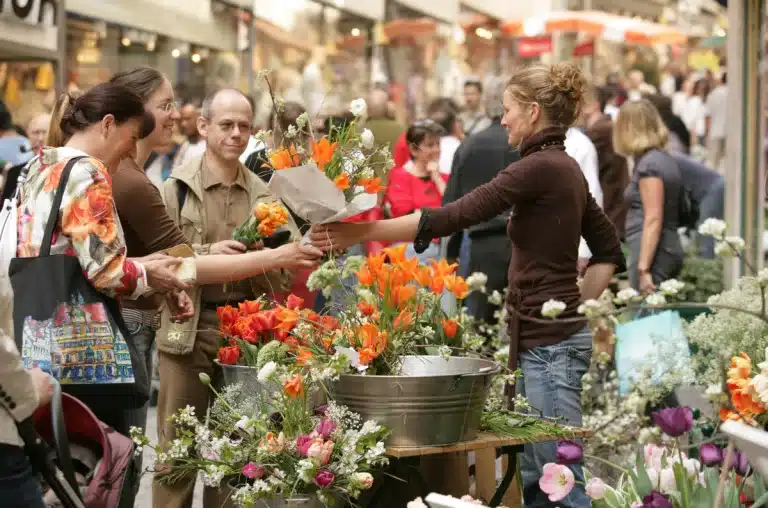
Lausanne’s pedestrian streets come alive with the arrival of the market on Wednesdays and Saturdays. Fruit and vegetable stalls set up shop on Rue de Bourg and the central Place de la Palud, while the Place de la Riponne features cheeses, charcuterie, bread, and an ever-expanding flea market selling paperbacks, CDs, bric-a-brac, and secondhand furniture. Look for the empanada stall on Rue du Pont for a quick snack, or join the line at the popular bread and cake stall in Riponne – their coconut macaroons are divine.
Author’s Recommendation :

Leave a Reply
You must be logged in to post a comment.